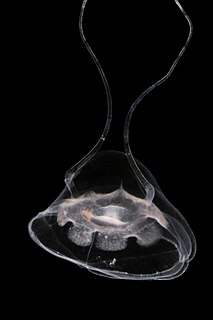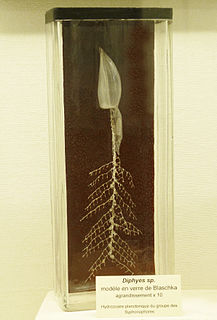
Hydroidolina is a subclass of hydrozoans in the phylum Cnidaria. It contains the bulk of the paraphyletic "Hydroida" which were one of the main groupings of the class Hydrozoa in older classifications and were placed at order rank. Hydroidolina also includes, however, the highly advanced colonial jellies of Siphonophora, which were not included in the "Hydroida".

Leptothecata, or thecate hydroids, are an order of hydrozoans in the phylum Cnidaria. Their closest living relatives are the athecate hydroids which are similar enough to have always been considered closely related, and the very apomorphic Siphonophora which were placed outside the "Hydroida". Given that there are no firm rules for synonymy for high-ranked taxa, alternative names like Leptomedusa, Thecaphora or Thecata, with or without the ending emended to "-ae", are also often used for Leptothecata.

Kirchenpaueriidae is a family of hydrozoans in the superfamily Plumularioidea. Their hydrocladia are characteristically set in an alternating fashion as one progresses along the stems, forming two neat rows except in Oswaldella laertesi, which has three such rows. The alternating placement of the hydrocladia can be used to distinguish them from the Plumulariidae which may look superficially similar.

Rhopalonematidae is a family of hydrozoans. The family comprises 15 genera and 36 species.
The World Register of Marine Species (WoRMS) is a taxonomic database that aims to provide an authoritative and comprehensive list of names of marine organisms.

Turritopsis is a genus of hydrozoans in the family Oceaniidae.

Haleciidae is a family of hydrozoans. Their hydroid colonies emerge from a creeping hydrorhiza and usually form upright branching colonies, although some species' colonies are stolonal. Their gonophores are typically sporosacs, growing singly or bunched into a glomulus. They remain attached to the hydroids or break off to be passively drifted away; in a few, the gonophores are naked.

Solmundella is a genus of hydrozoan in the family Solmundaeginidae. It is monotypic, with the single species Solmundella bitentaculata.

Hydractiniidae is a cnidarian family of athecate hydroids.
Maeotias is a genus of hydrozoans in the family Olindiidae. It is a monotypic genus with only a single species, Maeotias marginata, commonly known as the Black Sea jellyfish or brackish water hydromedusa and often referred to as Maeotias inexpectata in the literature. It was first described from the Don and Kuban estuaries of the Sea of Azov, and also occurs in the Black Sea, all of which are areas of low salinity. It has been recorded in several other estuarine locations around the world and is regarded as an invasive species.

The Diphyidae are a family of siphonophores. These are colonial siphonophores with two nectophores arranged one behind the other. The front one includes a somatocyst, while the hind one does not. The somatocyst often contains an oil droplet for buoyancy control. A nectosac in each nectophore allows the organism to swim efficiently.

Muggiaea is a genus of siphonophores in the family Diphyidae. Members of this family are colonial siphonophores with two nectophores arranged one behind the other, but in the genus Muggiaea, the posterior nectophore is absent. The anterior one has a complete dorsal ridge. The somatocyst is very close to the nectosac wall.

Capitata is a suborder of Hydrozoa, a class of marine invertebrates belonging to the phylum Cnidaria.

Filifera is a suborder of hydrozoans in the order Anthoathecata. They are found in marine, brackish and freshwater habitats.

Aplanulata is a suborder of Hydrozoa, a class of marine and freshwater invertebrates belonging to the phylum Cnidaria. The group have lost its planula larval stage, and the only remnants of the medusa stage is when they functions as gonophores attached to the polyp.

Spirocodon is a monotypic genus of hydrozoans with Spirocodon saltatrix as the only species in the genus. It is found in the north-western Pacific Ocean, and was first described in 1818 by the German naturalist and explorer Wilhelm Gottlieb Tilesius von Tilenau.
Octophialucium is a genus of Hydrozoan in the family Malagazziidae. The genus contains bioluminescent species.

Cunina is a genus of hydrozoan in the Cuninidae. The genus contains bioluminescent species.
Abyla is a genus of siphonophore in the Abylidae. The genus contains three species, some of which are bioluminescent.
Schuchertinia is a genus of commensal athecate hydroids in the family Hydractiniidae.
















